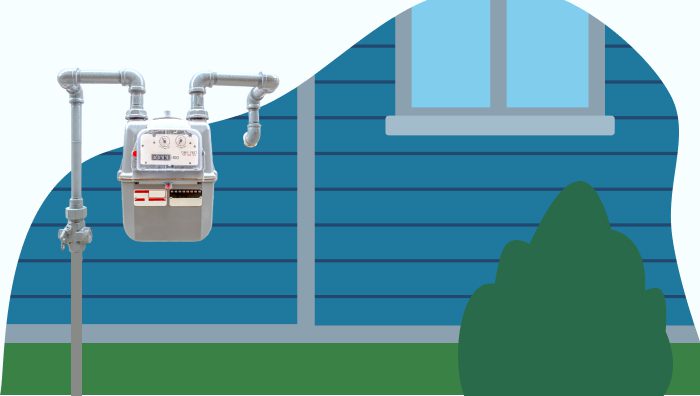How Natural Gas is Extracted, Delivered and Used in Your Home
by Tyler Castle
6.7 min read

Like 75 million other households across the country, if you depend on natural gas to power at least one appliance in your home, you’re not alone. As of 2020 (the most recent year with data available), the total number of gas-dependent appliances within these households had grown to 194 million, a 17.9 million unit increase from 2015. While natural gas is already one of the most-used energy sources in the country, this upward trend indicates that its popularity is rising.
But what is natural gas, exactly? How does it get to your house? How is it priced? Here, we’ll take a look at where natural gas comes from, its uses, what goes into determining your monthly bill, and how it compares to similar fuels. Keep reading to learn more about this power source.
What Is Natural Gas?
Put simply, natural gas is a fossil fuel energy source — meaning that it’s made up of the remains of plants and animals that have been trapped in the earth’s layers for millions to hundreds of millions of years. With time, certain conditions created by a mixture of pressure and heat converted these remains into either coal, petroleum, or natural gas.
In the case of natural gas, there are several different types that vary based on where in the earth they’re found (all of which can come from both on- and off-shore locations):
- Conventional gas comes from large cracks and the spaces between overlying rock layers.
- Unconventional gas is found within the pores of sedimentary rock formations.
- Associated natural gas occurs alongside crude oil deposits.
When it comes to the way natural gas is collected, drilling and a process called fracking — which involves injecting high-pressured liquids into boreholes to extract gas through the fissures it creates — are both commonly used methods. From there, the gas gets sent to processing plants where it is refined into the product that ultimately gets distributed to consumers.
How Does Natural Gas Get to My House?
Once it’s been through refinement, how does natural gas get from the processing plant to your home, and finally, to your appliances? Natural gas delivery involves a three-step journey that can span state lines, hundreds of miles, and an extended timeline.
The journey begins with processing, where the natural gas is treated to remove oil, water, and impurities such as sulfur and carbon dioxide. Once the natural gas meets set quality standards, it is ready for transportation and storage. Let’s take a closer look at what each of these steps involves:
Transportation
During transportation, the refined product travels from plants through a network of interstate or intrastate (if a plant is located within the state of destination) pipelines. If natural gas travels through interstate pipelines to reach its destination, it will also move through hinshaw pipelines, which are used to receive gas from interstate pipeline networks and pass it on to the consumer.
To enter individual homes, gas flows from these pipelines into localized networks called “mains” and finally into the service lines that connect the mains to residences.
Storage
Because demand for natural gas is subject to a variety of external factors — including seasonal shifts, temperature changes, and the state of the economy — and production tends to be fairly steady, there are times when storage becomes necessary. Storing natural gas in times when demand is low ensures that there will be enough supply once demand inevitably increases. Larger quantities of natural gas are stored in underground holding areas, while smaller volumes are kept in above-ground or shallow, below-ground tanks.
What Does Gas Control in a House?
Within the millions of households across the country that use natural gas-powered appliances, the most common applications are for heaters (such as furnaces), water heaters, ranges and ovens, and clothes dryers. These applications also tend to use the most natural gas.
Other household items, such as certain outdoor grills, lighting, pool and spa heaters, and generators, also rely on natural gas to work. However, since these are all used less frequently, their gas utilization is comparatively minimal.
How Is Natural Gas Priced?
This is the million-dollar question (or an amount that’s hopefully much less — if you receive a gas bill for one million dollars, get in touch with your gas company immediately!): What goes into calculating the balance you see on your monthly statement?
The first consideration is the price of the product itself. Price determination for natural gas is largely impacted by market supply and demand, which is dictated by:
- Supply-side factors such as production amounts, the amount of gas available in storage, and import and export volumes
- Demand-side variables like winter and summer weather conditions, rate of economic growth, and the price and availability of alternate fuel types
In addition to the price of the commodity, the amount you see on your bill is determined by your household’s monthly usage. This is measured by your gas meter, a device that’s located somewhere outside your home. Older meters keep track of and display how much natural gas flows into your home via a system of dials which are read from left to right. Each month a “meter reader” will come by to note the readings on behalf of the utility company.
However, more modern systems tend to include digital meters and automatic meter reading (AMR) technology.
Propane vs. Natural Gas: What’s the Difference?
Since both natural gas and propane are commonly used household fuels, it’s important to understand what makes each unique. On a scientific level, while natural gas is extracted directly from the earth, propane is either manufactured from natural gas or occurs as a byproduct of oil refinement.
But in a practical sense, how different are the two power sources? For example, could appliances meant to run on natural gas work if fueled by propane? The short answer is no. Due to the differences in their chemical makeup and specific pressure requirements, each should only be used to power their intended appliances and devices. That said, it is possible to convert a natural gas appliance to propane and vice versa.
See the chart below for more ways gas and propane differ:
| Natural Gas | Propane | |
| Availability |
Generally more readily available to consumers than propane |
Less readily available than natural gas |
| Source |
Directly extracted from the earth via drilling or fracking |
Created from natural gas or as a byproduct of crude oil refinement |
| Efficiency |
Less efficient than propane |
More efficient than natural gas — propane yields roughly double the amount of energy |
| Price |
Average prices fluctuate constantly, but natural gas is less expensive overall |
Average prices fluctuate constantly, but propane is more expensive overall |
| Environmentally friendly? |
More eco-friendly than other traditional fossil fuels, but less eco-friendly than propane |
Considered a green fuel as it is clean-burning |
Is There an Earth-friendly Option for Natural Gas?
The short answer to this question is yes! Here at Santanna, we offer an earth-friendly gas option for our customers. Through carbon offsetting, we’re able to reduce the impact of our emissions by making up for them elsewhere. That means when you choose an Earth-Friendly Gas plan with us, you’ll help make a positive impact on the environment.
When you choose our earth-friendly gas plan, you’ll help create ecological balance in the world just by heating your home. To find out more about what choosing this energy option means for you and the environment and to view plans in your neighborhood, visit us online.
Santanna Energy Services is a supplier of earth-friendly energy solutions, including earth-friendly gas, in the United States, providing services to Illinois, Indiana, Pennsylvania, Michigan, and Ohio. We provide a wide range of energy services and products to meet the needs of both residential and small business customers. Our mission is to provide innovative and cost-effective energy solutions that will help our customers achieve their energy goals. With over 35 years of experience, we are committed to creating life-long relationships by providing quality service to our customers, communities, and employees.
Tyler is an experienced energy professional, having worked for Santanna Energy Services, for the past four years. He is passionate about renewable energy and believes that diversifying the energy grid is the key to a sustainable future. Tyler is dedicated to supplying consumers with the best possible energy solutions and works diligently to make sure that Santanna can deliver the highest quality service.







